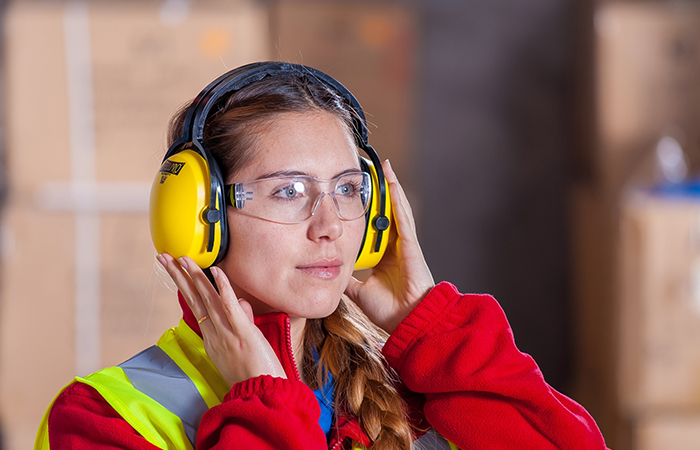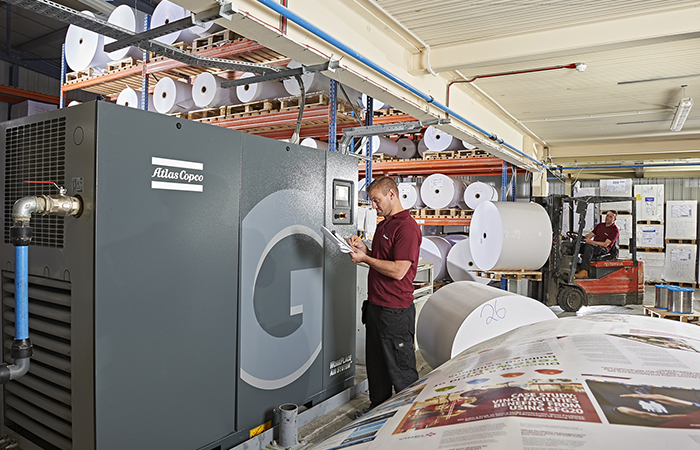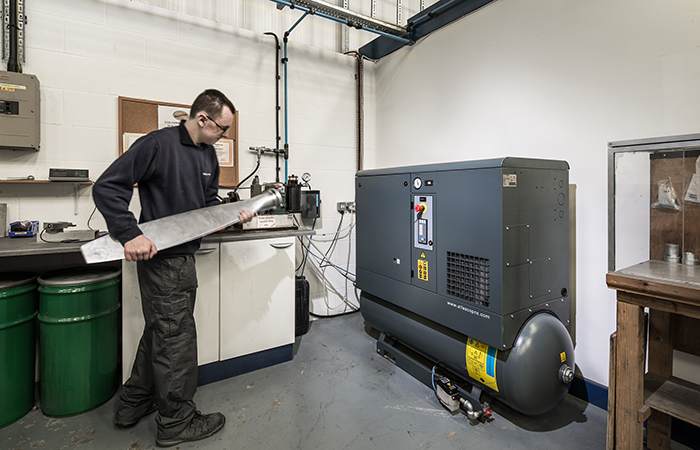
In this article Andy Pulley, Team Leader & Product Specialist with Atlas Copco Compressors examines the historic issues of noise emissions in factories related to air compressor operation and its effect on workers and productivity. He explains how today’s need for compliance with health and safety noise level regulations has influenced the development of innovative technology to produce a new generation of quiet compressors.
It is a matter of record that around 1 in 10 UK adults suffer from tinnitus and 1 in 6 are affected by other hearing loss. Overall, some 15 per cent of the population has suffered hearing loss as a result of sudden exposure to loud noise or long-term exposure to machinery noise emissions within an industrial environment. Probably the most extreme example of this problem was last century’s cotton mill workers deafened to the point that they were unable to communicate vocally even in close proximity to each other.

Working in a noisy environment long term can cause irritation, muffled hearing and increases the risk of developing tinnitus − vibration pressure waves are transformed into sound by tiny hairs in the ear that are flattened by excessive noise and result in the continuous ringing sensation. Noise can also make it harder for workers to hear alarms and warnings, presenting a safety hazard. In the most severe cases the outcome is irreversible hearing loss affecting workers’ communication, concentration and performance, which in turn impacts on productivity.
Since hearing loss is an issue, employers need take all the necessary actions to prevent this. All machines generate sound and vibration, so do compressors. The average noise level for an air compressor is 85 dBA. This is higher than a phone's ringtone, which is 70 dBA, but lower than most headphones that can go up to 110 dBA.
As set by the UK Control of Noise at Work Regulations 2005, employers are obliged to assess the risk to workers' health and provide them with information and training if the noise level is 80 decibels and above. Employers must provide hearing protection and hearing protection zones when daily or weekly average exposure is up to 85 decibels. Even taking into account any reduction in exposure provided by hearing protection, there an upper limit value of 87 decibels above which workers must not be exposed.

What causes air compressor noise?
All machines generate sound and vibration and, until recent times, such has been the case with workplace compressors. A compressor’s perceived noise level can be influenced by a number of factors, the most obvious of which is proximity - the closer the compressor was sited to the workforce, the greater the disturbance and discomfort level.
It is for this reason it has been common practice to isolate compressor equipment into separate and, more often, outdoor locations remote from the point of use. This action may have successfully mitigated vibration and noise issues but at the same time it will have incurred significant cost and productivity penalties resulting from pressure drops in the air network as a consequence.
The mechanical properties of different types of compressors plays a major part in noise creation, especially with reciprocating units operating with more moving parts that generate vibration. However, the physical properties of the room in which the compressor is installed can contribute significantly too.
Within its manufacturing process, a compressor’s noise level is measured by a standardised method in an acoustic free field e.g. outdoors, without walls or by means of a sound intensity scanning technique. When the compressor is installed in a production location, the noise level is influenced by the properties of the room. The size of the room, the materials used for the walls and ceiling, and the presence of other mechanical equipment and its potential noise levels all have significant impacts.
Furthermore, the positioning of the compressor within the room also affects the noise level due to the setup and connection of pipework through which mechanical vibration can be transferred.

Reducing compressor noise levels
Whilst housing a compressor in a separate room reduces noise levels dramatically on the shop floor or production hall, this is not always an option, especially in smaller factory units with limited spaces. As stated earlier, remote siting from the compressed air application area risks the possibility of a negative impact on operating economy.
Extended pipework runs increase the possibility of joint leakage and a reduction in working pressure. This directly affects a system’s power requirement. An increase in power to compensate for the pressure drop always results in an energy penalty and can prove costly – a 1 bar increase in pressure will result in an additional power requirement of approximately 6 per cent.
The solution is to opt for quiet workplace compressors, equipped with either a full or a partial enclosure that absorbs sound and reduces the noise level to below 80 dB. Machines designed from the outset to meet this requirement can be placed right next to the production line, without disturbing operators.
Because of their structure, piston compressors are the least quiet compressors. In contrast, rotary screw compressors are considerably quieter during operation as the air element helical screws do not touch one another. This is the reason that Atlas Copco’s innovative VSD+ compressors can run as low as 62 decibels. They form an important part of a whole new generation of powerful, quiet, oil-injected rotary screw workplace air compressors; developed to help operators meet the health and safety requirement related to noise.
For smaller business operators, such as automotive workshops, Atlas Copco’s G/GX range offers a quiet alternative to piston compressors through their use of rotary screw technology, which greatly reduces vibrations. These units provide users with a dependable source of compressed air, and can be located right in the heart of a workplace as they offer up to a 13 per cent reduction in noise levels compared to other compressors on the market.
Further up the scale, the principal game-changing innovation of the mid-range GA. VSD+ compressors design is in its close-coupled drive train − the combination of a high efficiency motor and technically advanced asymmetric compression element. Its IP55 motor was designed in-house with special attention to cooling requirements, efficiency and minimum noise emissions. With no coupling or gears between the motor and screw element the compressors are exceptionally quiet, as well as being extremely energy-efficient in performance. A unique contributary feature is the compressor’s patented cooling fan, which features a serrated upper profile to deliver silent operation.
A practical example of what has been achieved in terms of quiet compressor technology is summed up by the experience of world-leading engineered polymer solutions company Trelleborg. Commenting on the performance of the Atlas Copco full-feature GA VSD+ compressor installation at its Tewkesbury sealing solutions operation, its engineering spokesman had this to say about the benefit of its quiet operation:“The Atlas Copco VSD+ is so quiet that in the beginning I had to check that it was actually switched on!”










Emergency law passed to protect UK steelmaking
There is an old legal adage ´hard cases make bad law´ and it seems to apply to this draconian legislation, which gives sweeping powers to the...